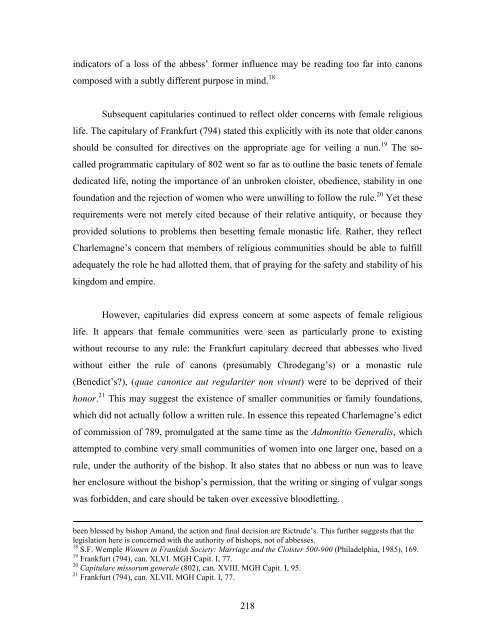Lindsay Rudge PhD Thesis - University of St Andrews
Lindsay Rudge PhD Thesis - University of St Andrews
Lindsay Rudge PhD Thesis - University of St Andrews
You also want an ePaper? Increase the reach of your titles
YUMPU automatically turns print PDFs into web optimized ePapers that Google loves.
indicators <strong>of</strong> a loss <strong>of</strong> the abbess’ former influence may be reading too far into canons<br />
composed with a subtly different purpose in mind. 18<br />
Subsequent capitularies continued to reflect older concerns with female religious<br />
life. The capitulary <strong>of</strong> Frankfurt (794) stated this explicitly with its note that older canons<br />
should be consulted for directives on the appropriate age for veiling a nun. 19 The so-<br />
called programmatic capitulary <strong>of</strong> 802 went so far as to outline the basic tenets <strong>of</strong> female<br />
dedicated life, noting the importance <strong>of</strong> an unbroken cloister, obedience, stability in one<br />
foundation and the rejection <strong>of</strong> women who were unwilling to follow the rule. 20 Yet these<br />
requirements were not merely cited because <strong>of</strong> their relative antiquity, or because they<br />
provided solutions to problems then besetting female monastic life. Rather, they reflect<br />
Charlemagne’s concern that members <strong>of</strong> religious communities should be able to fulfill<br />
adequately the role he had allotted them, that <strong>of</strong> praying for the safety and stability <strong>of</strong> his<br />
kingdom and empire.<br />
However, capitularies did express concern at some aspects <strong>of</strong> female religious<br />
life. It appears that female communities were seen as particularly prone to existing<br />
without recourse to any rule: the Frankfurt capitulary decreed that abbesses who lived<br />
without either the rule <strong>of</strong> canons (presumably Chrodegang’s) or a monastic rule<br />
(Benedict’s?), (quae canonice aut regulariter non vivunt) were to be deprived <strong>of</strong> their<br />
honor. 21 This may suggest the existence <strong>of</strong> smaller communities or family foundations,<br />
which did not actually follow a written rule. In essence this repeated Charlemagne’s edict<br />
<strong>of</strong> commission <strong>of</strong> 789, promulgated at the same time as the Admonitio Generalis, which<br />
attempted to combine very small communities <strong>of</strong> women into one larger one, based on a<br />
rule, under the authority <strong>of</strong> the bishop. It also states that no abbess or nun was to leave<br />
her enclosure without the bishop’s permission, that the writing or singing <strong>of</strong> vulgar songs<br />
was forbidden, and care should be taken over excessive bloodletting.<br />
been blessed by bishop Amand, the action and final decision are Rictrude’s. This further suggests that the<br />
legislation here is concerned with the authority <strong>of</strong> bishops, not <strong>of</strong> abbesses.<br />
18 S.F. Wemple Women in Frankish Society: Marriage and the Cloister 500-900 (Philadelphia, 1985), 169.<br />
19 Frankfurt (794), can. XLVI. MGH Capit. I, 77.<br />
20 Capitulare missorum generale (802), can. XVIII. MGH Capit. I, 95.<br />
21 Frankfurt (794), can. XLVII. MGH Capit. I, 77.<br />
218

















